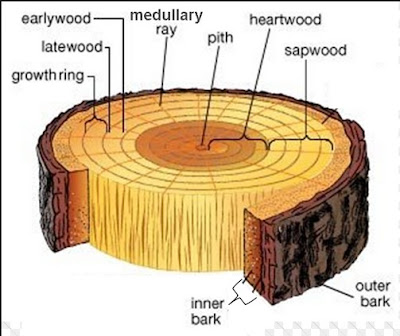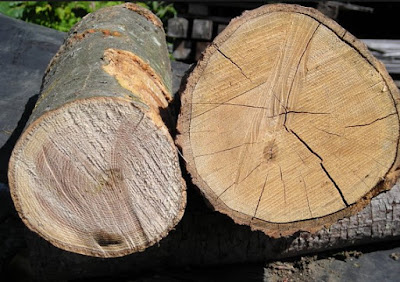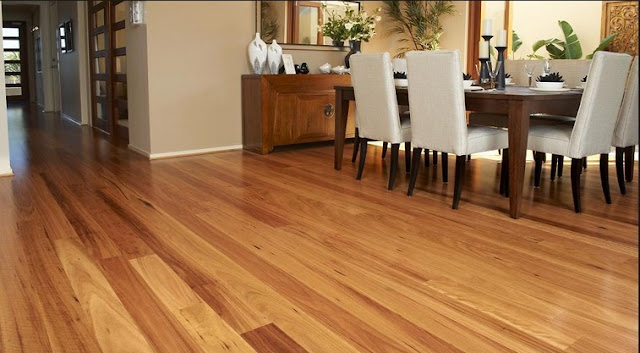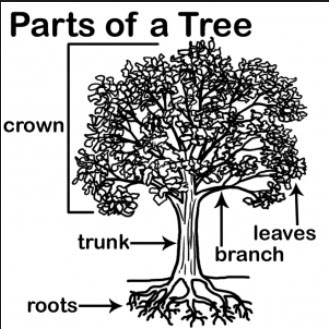We get wood from trees. Trees can be found in the forest, farms, gardens, and along the streets. The longer trees are left the bigger and taller they grow. When there are well grown, they are ‘fell’ and taken to the Saw-Mill where they are cut into marketable sizes.
Wood is one of the commonest used
materials because it is light, strong and be worked upon easily. Wood is used
in making furniture and cabinets. Wood
is used in building construction too.
Types
of wood
The two main types of wood and their
differences are:
HARDWOOD
|
SOFTWOOD
|
|
1
|
This
is wood from dicot angiosperm trees.
|
This
is wood from gymnosperm trees.
|
2
|
They
usually have broad leaves.
|
They
have needle-like leaves
|
3
|
Hardwoods
are mostly deciduous.
|
Softwood
trees are coniferous.
|
4
|
Hardwoods
tend to be slower growing.
|
Softwood
trees grow fast.
|
5
|
Hardwoods
tend to be found mixed with a variety of other species.
|
Softwood usually grows in huge
tracts of trees which may spread for miles.
|
6
|
The
seeds of softwood are naked.
|
The
seeds of a hard wood are enclosed.
|
7
|
Examples
include maple, balsa, oak, elm, iroko, opepe, mahogany, and sycamore.
|
Some
examples include pine, redwood, fir, cedar, and larch.
|
The
major parts of a tree
Root:
this holds the tree firmly to the
ground. The main function of the root is to hold the tree and absorb water and
minerals from the soil.
Trunk
or stem: this part acts as a support for the
branches, which it raises as high as possible towards the light. It is from the
stem or trunk that we get our timber.
The leaves: the
leaves are the most important part of a tree. The leaves carry out respiration,
photosynthesis and plant transpiration.
Branches are
the side shoots that originate from the bud.
Annual Tree Rings
record the tree’s age.
The crown
is the part of the tree that consists of the leaves and the branches at the top
of a tree.
The
cambium makes new cells during the growing
season that eventually become part of the inner back (Phloem)
The
sapwood (Xylem) is the youngest layer of
wood that transports water and minerals up to the branches and the leaves.
The
inner bark (Phloem) carries nutrients and
sugar from leaves down to the tree to its branches, trunk, and roots.
Heartwood
is the inner core of dead wood that
supports the tree.
CLASS ACTIVITY:
describe the following parts of a tree:
1.
Branches:____________________________________________________________________________________________
2.
Leaves:_______________________________________________________________________________________________
3.
Bark:_________________________________________________________________________________________________
The
Structure of Wood

Wood is made up of a number of
tiny-like units called cells. These cells are called Fibres or Tracheids.
They vary in length, but the strength of the wood primarily depends on the
thickness of the cell walls
Features
of wood
As shown in the diagram above, when
a tree is felled the cross-section will show the Pith, the Back or Curtex, the
Sapwood, the heartwood, the annual rings,
the cambium Layer, and the Medullary Rays
Class Activity:
Describe the following parts of the cross section of a tree:
1. The cambium layer:
2. Sapwood:
3. Heart wood:
4. Medullary Rays:
5. The Annual Growth Ring:
6. The Pith:
7. The Bark or Curtex:
Wood
Processing:-
Wood processing is the process it takes to
fell a timber tree in the forest, take it to a sawmill then process it into
timber planks. Wood can be fell from two different areas, which are the free
area and the forest reserved area. The wood can be transported to
the sawmill through Lorries, river or
rail.
Wood
Conversion is the cutting of splitting of
wood into marketable sizes.
WOOD
SEASONING:
Wood Seasoning is the removal of
water or moisture content in wood.
Method of wood seasoning:
1
1. Artificial Seasoning: through the use of ‘kiln’
2. Natural seasoning: through air drying.
1. Artificial Seasoning: through the use of ‘kiln’
2. Natural seasoning: through air drying.
Reasons for seasoning wood:
1. It makes the wood more durable
2. It makes the wood lighter in weight
3. It reduces the moisture content
4. It makes the wood more stable
5. It minimizes or prevents attacks from water, bacteria and fungi.
Calculation
of the Moisture Content of wood
The moisture content of the timber
can be calculated using the formular:
Moisture
Content (M.C) = (weight of wet wood – weight of dry wood) x 100
Weight of dry wood
Example: A piece of timber
weighed 120kg before drying and 100kg after drying. Find the moisture content
of the timber.
Solution:
Wet
Wood = 120kg
Dry
Wood =
100kg
M.C. =(weight of wet wood
– weight of dry wood) x 100
Weight of dry wood
M.C.= (120 – 100) x 100
100
1
M.C. = 20%
Class Exercise:
1. A piece of timber weighed 88kg before drying and 70kg after drying. Find the moisture content of the timber.
Mention 10 uses of wood.
Wood
Preservative
This is a process of treating wood
with chemicals called preservatives to prevent insects’ attack and therefore
prolong the service life of the wood.
Methods off Applying
Preservatives;
1.
Types of preservatives:
1.
Tar oils
2.
Water borne
3.
Solvent type
Exercise:
1.
What
is wood?
2.
What
is the main source of wood?
3.
What
are 6 distinctive differences between softwood and hardwood?
4.
What
are the major parts of a tree?
5.
How
can the cross section of a tree be drawn and label it correctly?
6.
What
are the parts of the cross section of a tree?
7.
What
is wood processing?
8.
What
is wood conversion?
9.
What
is wood seasoning?
10. What are the two
major types of seasoning?
11. Why is wood
seasoning recommendable?
12. How can you
calculate the Moisture Content of a piece of timber that weighed 120kg before
drying and 100kg after drying?
Homework:
1. What is metal?
2. What are the three
main types of metal?
3. What is Metal
Processing?
4. What is a furnace?
5. How can a furnace
be described?
Author: Precious Ikpoza

















No comments:
Post a Comment